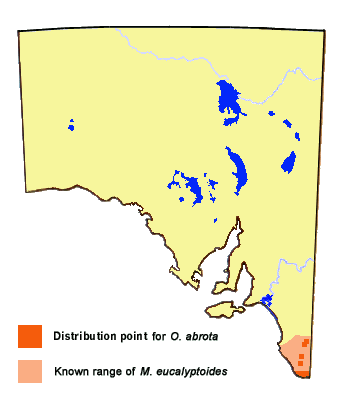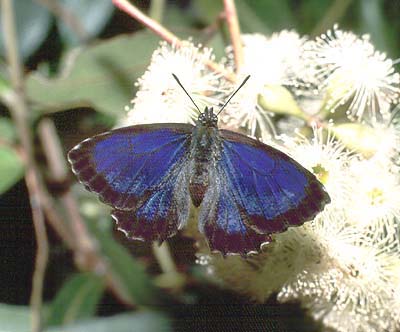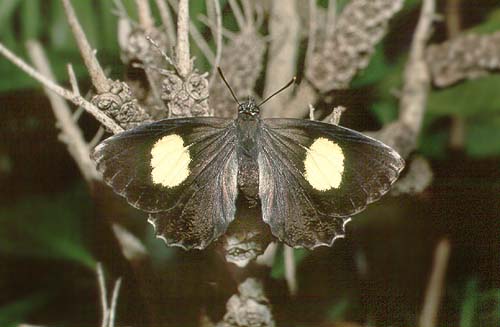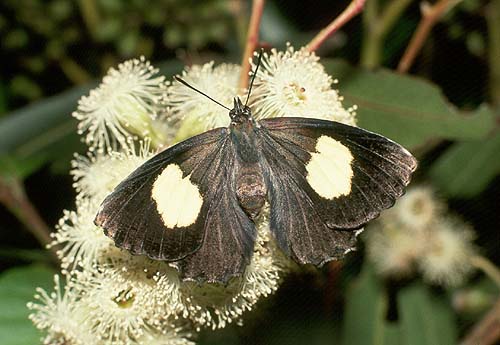-
Larval Food Host
-
In South Australia, the butterfly is known to only utilise
Muellerina eucalyptoides (creeping mistletoe) (Loranthaceae).
The mistletoe associates mainly with Eucalyptus, where it usually attaches high
up in the crown of the tree. It has a particular fondness for red gum (E. camaldulensis).
It also is commonly found on Acacia melanoxylon. The mistletoe is also sometimes
found on exotic garden plants in the urban environment. The larvae eat the flower buds,
flowers, leaves and soft stem parts of the mistletoe, but are particularly fond of the flower buds.
-
Larval Attendant Ant
-
In South Australia, larvae are always attended by ants of a small black
Iridomyrmex species that are very strong smelling,
and which raise their abdomens into the air when agitated. These ants occur
as either small or smaller types. In the eastern states other ants known to
attend larvae include Anonychomyrma sp, Crematogaster sp,
Froggattella kirbii, Rhytidoponera sp and Technomyrmex sp.
-
Eggs
-
Small, initially pale green, later becoming blue-white to white, having a flattened
hemispherical shape. The sides are fine to very finely reticulated in a hexagonal
pattern, with each reticulation intersection having a small raised blunt projection.
The facets on the top of the egg are smaller and are of irregular shape and these
continue to the small-depressed micropylar area at the apex of the egg. The shape
and surface texture of the egg is not too dissimilar to the eggs of the Ogyris
members in the O. idmo Species-group.
Eggs are laid singly or in small batches (3-6), on the leaves, stems and bole (base)
of the foodplant, and also on the adjacent host plant. They are often laid in crevices
and under loose bark. In some areas where the butterflies are common, there are
populations of tiny parasitoid wasps on the mistletoes and many of the eggs suffer
parasitisation.
-
Larvae
-
The first instar is long onisciform shaped, grey-brown with a narrow brown longitudinal
dorsal line broadly edged pale yellow, dark grey subdorsal spots are sometimes obvious,
and there is a pale yellow lateral line. The posterior dorso-lateral organs are not
developed. The head is large, smooth, yellowish brown, hidden beneath the body. The
prothoracic and anal plates are black. There are long peripheral and dorsal setae,
which are very much longer anteriorly and posteriorly. The lateral setae are white,
while the rest are black. Dorsal setae occur in two pairs, one pair being long and
recurved, the other pair being short, recumbent and directed to the rear. After eating
the foodplant, the larvae gradually become a mottled brown and yellow colour, with
a brown dorsal line. The first instar is very similar to that of O. genoveva,
suggesting another primitive link with the O. idmo Species-group.
Intermediate instars gradually lose the long setae, and gain the posterior dorso-lateral
organs. The second instar is similar to the late first instar. The third and fourth
instars are similar to the fifth instar but are dark brown.
The first instars are very mobile, and quickly look for the foodplant to start feeding.
The first instar larvae remain exposed on the leaves and stems of the mistletoe. Later
instars hide and shelter during the day, and feed at night. They shelter under coarse
old bark near or on the foodplant, or in crevices in the mistletoe host, or in borer
holes or ant tunnels in the mistletoe or mistletoe host. These older larvae will
aggregate together if the shelter is large enough. The numbers of larvae feeding on a
mistletoe that is being utilised by the butterflies are variable, usually depending on
the size and health of the mistletoe, and whether there are good hiding places present
for the larvae. The numbers can vary from just a few larvae, to a dozen or more.
The fifth (final) instar is about 23-27 mm long, pale brown coloured, sometimes purplish,
with some indistinct pinkish and reddish markings dorsally,there are pale yellow dorsal
chevron markings and other indistinct subdorsal markings, the chevrons on abdominal segment
6 are joined together to form a yellow triangular mark, the posterior extremities also have
yellowish markings, the prothoracic plate is grey, the anal plate is yellowish with a black
longitudinal dividing line, and the spiracles are white rimmed black. Onisciform shaped with
a thoracic dorsal furrow, the lateral edges are weakly scalloped, and the anterior and
posterior areas are flattened, and there are some short peripheral hairs that are longer
anteriorly and posteriorly, and some black paired dorsal bristles on abdominal segments
4 and 5. The body is covered in pale and dark coloured, minute secondary setae, which are
recumbent, club shaped and rough in appearance, set on a protuberant,angular and ridged base.
The secondary setae impart a scabrous appearance to the larvae. The posterior dorso-lateral
organs are well developed. The head is small, smooth, brown, hidden beneath the body.
These larvae are more flatter (or wider) than larvae of similar Ogyris within the
species-group.
-
Pupae
-
Short cylindrical, rounded anteriorly and posteriorly, about 14-17 mm long, pale brown,
yellowish or pinkish on the abdomen, greyish elsewhere, with a dark brown dorsal line,
a subdorsal row of dark spots on the abdomen, and a posterior yellow dorsal patch on
the abdomen. The surface of the pupa is without hairs, but bears a reticulated pattern
(similar to the eggs) that produces a very fine scabrous surface, and which includes
minute specialised secondary setae that are more common around the spiracles.
Pupation usually occurs in the first lot of secure bark at the base of the mistletoe or
on the adjacent host tree, often in the first crook of the tree below the mistletoe.
Larvae usually pupate singly, but will also pupate near to other pupae if they happen
to be present. Pupating larvae surround themselves with a loosely webbed, silken
cocoon-like shelter, which presumably affords some protection from larger predators, or
perhaps from other Ogyris larvae which can cannibalise soft pupating larvae.
There is normally space within the silk webbing for the small attendant ants to pass
through to attend to the live pupae. Pupae are attached to the silked substrate by anal
hooks and a central girdle. There are usually several ants in attendance with the pupa.
The pupa period is variable, depending on the time of year, being about 3-4 weeks in
spring, 10-17 days in summer, and about 19-20 days in early autumn. As for most of
the Ogyris butterflies, emergence of the butterfly from the pupa is rapid,
and it is flying within about 45 minutes. Like many Lycaenidae that are attended by
ants, but particularly many of the Ogyris, the butterflies emerge with the body
covered in large quantities of fluffy grey 'down', which is discarded when the butterfly
first flies. This down helps protect the butterfly from being attacked by over-zealous
attendant ants, or even other small predators, while the butterfly is expanding and
hardening its wings in readiness for first flight.
The pupae will readily stridulate, making a series of audible clicks, which are believed
used as a means of communicating with the attendant ants.
-
Flight Period in South Australia
-
The few flight records from South Australia are from late December to early April.
The butterfly is likely to fly throughout the warmer months, but with the greatest
activity during the flowering of its mistletoe foodplants, which are used for
nectaring purposes by the adults. In Victoria, the main flight of the butterfly is
from September to March, peaking in October, November, February and March. The brood
period in South Australia is about 12 weeks during late summer-early autumn. There
are probably two main generations in the Lower Southeast. Larvae go into a torpid
(semi-hibernation) state over winter.

-
Distribution
-
The species is only found where its Muellerina foodplants occur, and these are
present only in the Lower Southeast Region of the state. The butterfly also occurs in
the eastern states, wherever its foodplants occur.

-
Habitat
-
The butterfly occurs in cool temperate woodland and forest, both open and closed,
and is one of the few Ogyris that will occur in the urban environment,
with butterflies present in urban Naracoorte. Its larval foodplant requires moist
temperate conditions with an average annual rainfall in excess of 600 mm.
-
Conservation Status in South Australia
-
The butterfly is rare in its occurrence in South Australia.
-
Threats
-
Historically, large areas of the butterflies' habitat was destroyed and fragmented
by clearing. Fortunately, many of the large Eucalyptus were saved as a cover
for the stock, and these trees invariably carried the Muellerina mistletoe.
The butterfly can exist on these isolated trees, and therefore the butterfly can be
considered as not being under threat except where the habitat is adjacent to or within
farming and vineyard communities, and affected by poison spray drift during crop spraying
activities, especially when the poison is applied by aerial means. In urban areas, its
mistletoe foodplants are usually considered as pests on exotic garden ornamentals and
removed from their hosts. There has been a recent spate of clearing activities in the
Lower Southeast for new vineyards (in particular), and unfortunately this clearing includes
the large red gums with their Muellerina mistletoe.
-
Conservation Strategy
-
Spraying activity should be carried out judiciously. Considerable thought should be
undertaken before the removal of the ancient red gums. (Removal is permanent, and
includes the huge bio-fauna existing on the gums.) In urban areas a public education
process is required for the Muellerina mistletoe. Healthy trees are able to
support this mistletoe, and there is usually a self-induced balance between the tree
host and the mistletoe. If there appears to be an imbalance then it should not be a
problem to thin out some of the mistletoe. An active Ogyris colony will help
keep the mistletoe pruned. It is a privilege to have the butterflies flying in a garden.





